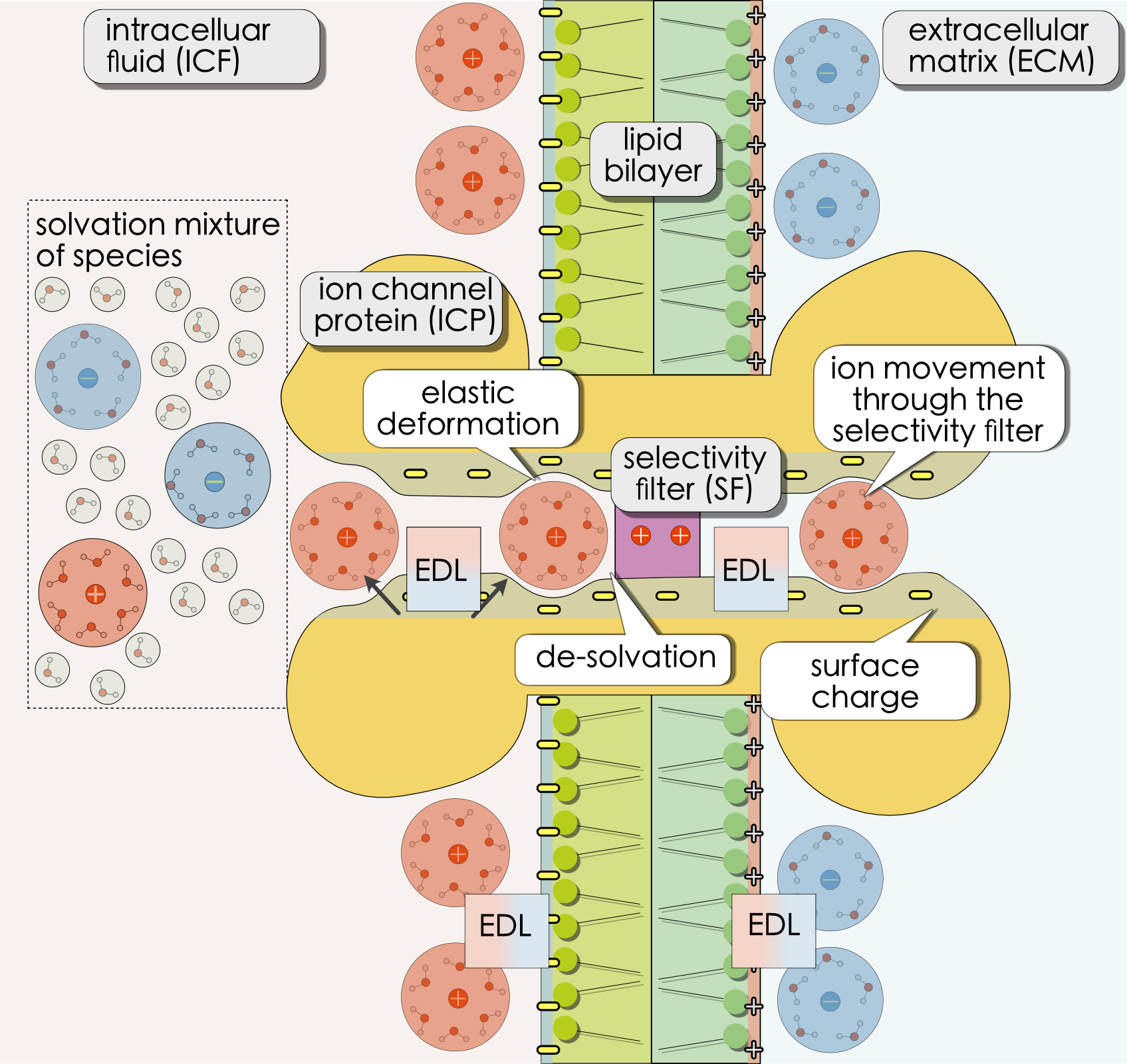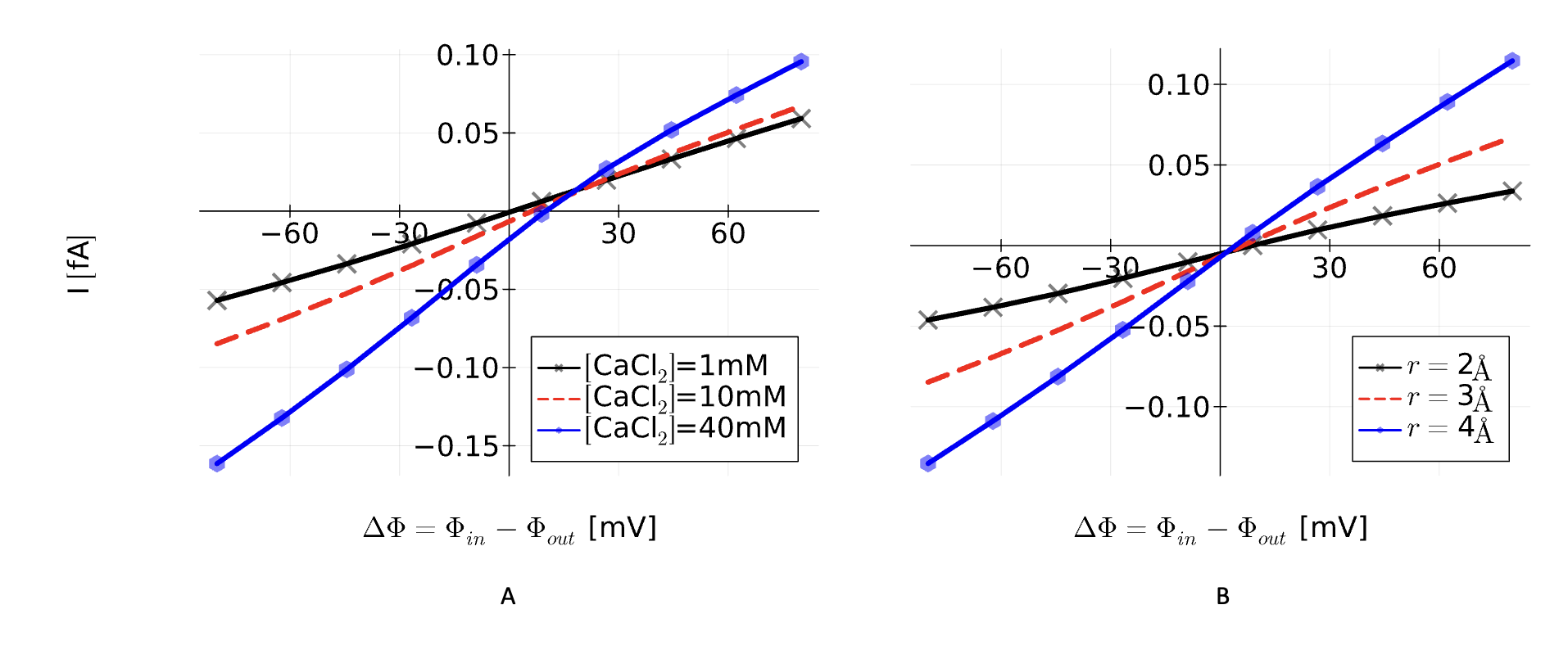Development of an Ion-Channel Model-Framework for in-vitro assisted interpretation of current voltage relations
Project heads : Manuel Landstorfer, Jürgen Fuhrmann, Barbara Wagner
Cooperation partner: Robert S. Eisenberg (Rush Univ. Chicago)
Project staff : Christine Keller
MATH+ link :https://mathplus.de/research-2/application-areas/aa1-life-sciences/aa1-14/
Summary
We develop a PDE based model framework to predict current-voltage relations of calcium channels for varying concentrations, voltages and channel elasticity to help interpret measured results. Theory and numerical approaches treat progressively more complex models covering mechano-sensitivity and selectivity.
Description
Ion channels control a large fraction of biological processes and are important targets for curing medication. Like valves and transistors, they are “devices’’ which allow to control macroscopic system behavior with small energetical input. The behaviour of ion channels, even single ion channels, can be studied in laboratory conditions by measuring the current response to some time dependent voltage difference. This signal is a unique signature of a channel and its environment and depends on various local and global quantities.
The interpretation of measured current voltage (IV) relations, and especially their variation with the structure of the channel protein and bulk ion concentrations is of great importance for biology, physiology and medicine.

Sketch of a deformable ion channel modeled as a multidomain heterostructure.
Theoretical investigations of ion channels use methods from quantum chemical approaches via molecular dynamics (MD) simulations to PDE based models. While MD simulations resolve an ion channel on the atomic scale, enabling detailed investigations of the channel protein, they lack predictability on IV relations and bulk concentration variations, e.g. of Ca\(^{2+}\) concentrations from \(10^{-8}\) to \(10^{-6}\) M.
Continuum based, molecular mean field theories essentially yield averages of trajectories of MD simulations . They treat the ion channel as a geometric domain without resolving all its atoms explicitly in space and allow to yield IV curves via numerical simulations. The project aims at the development of a continuum based mathematical and numerical modeling framework from first principles of non-equilibrium thermodynamics.
Methods
To describe ion activities in the channel we use a model-framework that has been developed to model metal-electrolyte interfaces . The model accounts for different phenomena such as space-charge competitions, excluded-volume effects and the surface charges of the channel. The electrolyte in the intracellular and extracellular fluid consists of an incompressible solution mixture with \(N\) ion species \(A_\alpha\), e.g. \(A_0 = H_2 O\), \(A_1 = Ca^{2+}\). The evolution of the molar densities of the species \(A_{\alpha}\) are described by a drift-diffusion equation. The electric potential is calculated by a Poisson equation. From a coupling between mechanics, incompressibility of the fluid and electrostatics we gain an additional equation for the pressure inside the electrolyte. Surface charges like those of the proteins are included in the model by Neumann boundary conditions.
Many ion channels are selective to specific ion species and there are different mechanisms that contribute to such a selectivity: electrostatic forces, chemical reactions and size exclusion. Within our model we include the selectivity filter as an additional embedded domain and define charge transfer and desolvation reactions at the interfaces. The reactions are incorporated into the model as Neumann interface conditions.
The model is solved numerically in Julia using the VoronoiFVM.jl
package . The Voronoi Finite Volume Method is thermodynamically
consistent as well as positivity preserving, and mass conserving .
We are able to calculate current-voltage relations under different
conditions such as varying channel properties and ion
concentrations.
Results

Calculation of current-voltage (IV) relations for a mixture of sodium, calcium, chloride and water. The model was solved in a steady state, including a surface charge on the channel wall and without selectivity filter. As domain we use a simplified 2d cylindrical symmetric geometry. A: different calcium concentrations in the extracellular domain. B: different channel radii.


